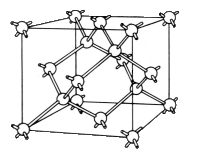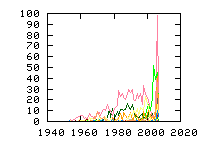« Previous
1
Next »
(3 hits, 1/1)
Showing
10, 25, 50, 100, 500, 1000, all papers per page.
Sort by:
last publication date,
older publication date,
last update date.
- 1. Appl. Phys. Lett. 87, 172108 (2005) , “Production of native donors in ZnO by annealing at high temperature in Zn vapor”, L. E. Halliburton, N. C. Giles, N. Y. Garces, Ming Luo, Chunchuan Xu, Lihai Bai, L. A. BoatnerZinc oxide crystals grown by the seeded chemical vapor transport method have been annealed in zinc vapor at 1100 °C for 30 min. These thermochemical reduction treatments produce a deep red coloration in the crystals and increase their n-type electrical conductivity. Electron paramagnetic... (Read more)
- 2. Phys. Rev. Lett. 85, 417 (2000) , “Extreme Reduction of the Spin-Orbit Splitting of the Deep Acceptor Ground State of ZnS- in Si”, H. Schroth, K. L. La?mann, S. Vo?, H. Bracht.Electric-dipole spin resonance of the deep acceptor ZnS- in Si reveals close Γ8 and Γ7 ground states with zero-field separation of only 0.31 meV as compared to the 43 meV of the two valence bands. With Landé's formula for the g factors of a 2T2 state split by spin-orbit interaction into Γ8 and Γ7 this nearness can be interpreted as strong quenching of the orbital moment. The observed dependence on the Zn isotopic mass indicates a dynamic contribution of the acceptor atom to the electronic state as is expected for a Jahn-Teller effect. (Read more)
- 3. Appl. Phys. A 30, 1 (1983) , “Transition Metals in Silicon”, E. R. Weber.A review is given on the diffusion, solubility and electrical activity of 3d transition metals in silicon. Transition elements (especially, Cr, Mn, Fe, Co, Ni, and Cu) diffuse interstitially and stay in the interstitial site in thermal equilibrium at the diffusion temperature. The parameters of the liquidus curves are identical for the Si:Ti — Si:Ni melts, indicating comparable silicon-metal interaction for all these elements. Only Cr, Mn, and Fe could be identified in undisturbed interstitial sites after quenching, the others precipitated or formed complexes. The 3d elements can be divided into two groups according to the respective enthalpy of formation of the solid solution. The distinction can arise from different charge states of these impurities at the diffusion temperature. For the interstitial 3d atoms remaining after quenching, reliable energy levels are established from the literature and compared with recent calculations. (Read more)
« Previous
1
Next »
(3 hits, 1/1)
Showing
10, 25, 50, 100, 500, 1000, all papers per page.
Sort by:
last publication date,
older publication date,
last update date.
All papers (3399)
Updated at 2010-07-20 16:50:39
Updated at 2010-07-20 16:50:39
(view as: tree
,
cloud
)
| 1329 | untagged |
Materials
(111 tags)
Others(101 tags)
Technique
(46 tags)
Details
(591 tags)
Bond(35 tags)
Defect(interstitial)(18 tags)
Defect(vacancy)(15 tags)
Defect-type(19 tags)
Element(65 tags)
Energy(8 tags)
Isotope(56 tags)
Label(303 tags)
Sample(17 tags)
Spin(8 tags)
Symmetry(15 tags)

